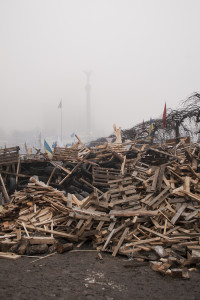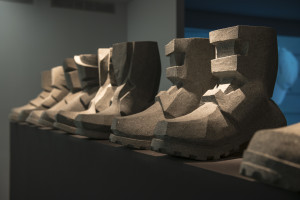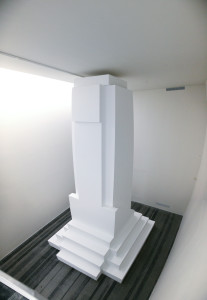The publication Revisiting Footnotes: Traces of the Recent Past in the Post-Socialist Region aims to capture and analyse the persistent Soviet era traces or references in art, public space, architecture, society, the field of collective and individual memories. Similar to footnotes in a book, the translated references – various processes, events, artefacts, symbols, systems, mythologies and nostalgias – give a kaleidoscopic commentary, elaborate and bring closer narratives about the recent past.
If after the collapse of the USSR, a common tendency was to purposefully forget the Soviet period, the passage of time now allows seeing beyond the painful experiences and undertaking its culture-anthropological archaeology. Contributors to this publication belong to the generation that revisits the consciously forgotten socialist past, yet their interest is rather an attempt to investigate and understand the conditions of contemporary reality that are still tied with the heritage of the past. They explore, interpret and translate this experience through both visual imprints and the interrelationships of their meanings. They treat the past and the present as belonging to the same timeline, which also contains potential scenarios for the future.
Edited by Ieva Astahovska and Inga Lāce. Published by the Latvian Centre for Contemporary Art. Below, we are reprinting Mykola Rydnyi’s contribution to the book.
Foresight, Involvement and Helplessness: The Role of Culture in the Political Transformations in Ukraine
30. 06. 2014
In the context of the Orange Revolution in 2004 and the events of 2013-2014, the Ukrainian word ‘maidan’ has become a political and international term. This word now means not only a square in the city centre, but is also a synonym for revolution. In the early 21st century the protest events incited socially critical gestures in Ukrainian contemporary art, so the context brought about a new generation of artists that considered art as an extension of and a toolkit for showing one’s civic attitude. It now becomes clear that this was largely possible due to the peaceful nature of the 2004 protest. The analysis and reflection made by those artists in regard to the social and political transformations in the Ukrainian society in recent years is being perceived today as a foresight of the current events.

Here are some of the symptomatic artistic statements. Volodymyr Kuznetsov’s work Koliivshchyna. Judgment Day (2013), which was dedicated to the issue of clericalism: a mural painting that refers to the iconography of the Last Judgment, portraying politicians, policemen and clerics boiling in the hell pot, which became a harbinger of the protest explosion resulting from the tension and injustice accumulated in the Ukrainian society. Koliivshchyna was censored at an exhibition in the museum complex Mystetsky Arsenal, which essentially provoked a situation of maidan inside the art community. Like President Viktor Yanukovych, who kept pretending that nothing was happening around him while the protests unfolded, the museum director Nataliya Zabolotna kept pretending she hadn’t performed an act of censorship, presenting her decision to paint the mural over as a regrettable misunderstanding. That same year I was working on the project Constant Dropping Wears Away a Stone, making an interview with an ex-policeman. The former police officer, who’d become a stone carver, made granite objects in the shape of policemen’s boots for me, which I later used to make a sort of a checkpoint at the exhibition. In doing this, I spoke about the danger of Ukraine becoming a police state, but I didn’t actually think that it could happen so fast. On December 2, 2013, something that we already feared took place – the crackdown and beating of peaceful citizens at Maidan, which provoked mass street protests. On December 9, the guards of PinchukArtCentre, where the piece was exhibited, blocked the doors of the institution in the fear of uncontrolled people’s aggression. The reason for that was the radicals toppling Lenin monument a hundred metres further, pulling it down from its pedestal and crashing it into small pieces. In the art community we recalled Nikita Kadan’s Pedestal. Practice of Exclusion (2009–2011) at that time, which touched the issue of the ‘war on monuments’, led by the adherents of Russian imperial fanaticism, and Ukrainian nationalists. The same happened in that particular situation in Kyiv: the place of the leader (vozhd’) became empty, while the pedestal was covered with patriotic slogans. There are more examples of artistic expressions that have come up in memory since the protest events started, but there is unfortunately not enough space to mention all of them. It is symptomatic that art, which was created in the period between the two Maidans, took over the place of weather forecast in a way, which no one would treat as a foresight, yet it proved to be an adequate and truthful warning.

Series of objects, granite
In its turn, the new Maidan events took away the moral right to regular artistic life, demanding active involvement. These were different sorts of activities, from volunteering to performing the educational function. The latter was brought to life within the Open University of Maidan initiative – an outdoor stage, where screenings and lectures by artists, sociologists, culturologists, lawyers and others took place. This small stage was a democratic alternative to the main stage, where opposition MPs appeared, who later would fill the new government. In the meantime, Maidan had generated an unprecedented increase of self-organization, people living in tent camps, cooking, cleaning, patrolling, building barricades, demonstrating a model of horizontal, non-hierarchical relations.
Everything changed after January 16, 2014. The protest transformed to violence, becoming a severe confrontation between activists and the police after the authorities’ attempt to pass new dictatorial laws aimed at constraining human rights. The violent protest was a new shocking experience not only for Ukraine, but for the whole Europe. January 22 was the day of mourning for the first activists killed. That was the moment when internet and the social media, functioning as the voice of the protesters, shifted to the highest level of tension, as the analysis of events was replaced by people’s emotions. Under a range of affects, not only Maidan had changed, but the whole Ukrainian society faced changes. Naturally, the domains of art and culture fell out of consideration. Losing their relevance for a time, they moved beyond the horizon of perception, their means of expression pushed out by the social and political disturbances, the first victims of which were only the start of an endless cycle of new ones. As is well known, every action has an opposite reaction; force confronts another force, and violence breeds new violence. Yanukovych’s escape rather marks a milestone, not a moment of victory – causing a wave of reaction in Eastern Ukraine, when the confrontation between the authorities and the people became a conflict between different parts of the population. In Kharkov, Donetsk, Lugansk and Odessa the phenomenon of Anti-Maidan emerged, having been dormant before.

Together with the doubtless positive aspects of Maidan, such as the creation of a platform for the civil society, grassroots self-organization and the horizontal system of relations opposing the power vertical, there was another side to it as well. The actions performed by the authoritarian, right-wing fraction of the protest – imposing their rules and arrangements, conducting reprisals against their opponents, chanting racist slogans – were splitting up the protest and polarizing the public mood. The far right activists were a minority in Maidan, however this minority was loud and stirring. The Anti-Maidan copied many things from Maidan, adding however a much higher grade of brutality, savagely humiliating, hunting their adversaries, replacing the Ukrainian nationalist slogans with pro-Russian rhetoric. The culture of communication, dialogue and discussion had suffered a defeat. Maidan and Anti-Maidan activists in Eastern Ukraine tried to find common ground, organizing negotiations and conferences together, but the actions of the radicals eventually caused a transition to the language of violence. The situation illustrates the problem of competitiveness of culture against aggressive propaganda, populism and political manipulations. In this context, conversation will always be overtaken by shouts, as complexity will be covered by simplification and discussion will be replaced with monologue.
The only thing left for culture in the situation of post-Maidan is functioning beyond the tension, opposing mass-media propaganda and mass hysteria: when war is in the regions of Donetsk and Lugansk, discussion can only be held in the neighbouring Kharkiv, which is receiving a mass flow of refugees, who hope for the city not to share the same fate as the nearby regions. In Donetsk itself, cultural dialogue ended up in an armed conflict. A case in point is the takeover of the contemporary art centre Izolyatsiya by the militants of Donetsk People’s Republic, who seized its premises and part of its collection. At this rate, culture seems to be constantly late; although generating opinions, asking the right questions and quite often doing it before everyone else, it becomes totally helpless when the conversation is carried out from a position of strength, thus losing any capability to influence the situation.
Representation of Maidan creates another problem for culture. After the events of winter 2013 – 2014 in Kyiv a number of exhibitions and initiatives related to the topic have taken place. Most of them were far from analysis and understanding of the temporal complexity of Ukraine’s situation, romanticizing and glorifying Maidan, which often trenched upon vulgarity, and, most importantly, described the events as a full-fledged and accomplished phenomenon. That kind of approach is not far from the mass-media rhetoric, which tends to flatten the ambiguity of the situation, presenting patriotic bravado instead, falling into the logic of the media war with Russia. Heroism is often mixed with sarcasm and mocking the defeated, for example, in the exhibition of kitsch objects taken from the ex-president’s residence at the National Art Museum, where “the defeated other” became a laughing stock, whereas the space for the viewer’s self-irony lacked. Much the same is the level of Maidan representation abroad, which is also problematic. Two exhibitions are revealing in this context: I am a Drop in the Ocean in Künstlerhaus, Wien, which shows a set of artefacts and protest evidence based upon their exoticism, without problematizing their origin, and The Ukrainians in DAAD gallery, Berlin (2014), which, on the contrary, tries to engage in reflection of events, to analyze their context and consequences. Despite the huge intellectual and visual difference, both exhibitions speak of the problems of others, not problematizing their own context, where Western Europe is backing up its own business interests with populist statements on solidarity and democracy.
The experience, which art and culture have gained with the recent events in Ukraine, shows that culture as an instrument for dialogue and discussion in the society is possible only if the society is ready for such a dialogue. Culture cannot speak when gas grenades, baseball bats, Kalashnikovs, tanks and armoured vehicles speak – then its right to speak is taken away. Culture is not able to react as lightning-fast as the media during the media war. For all that, does culture have a chance to influence social processes in such extreme conditions? I want to believe it does, although it is always late – deep and thoughtful analysis doesn’t work in situations when only the most loud and harsh voices are audible. I want to believe that as soon as the political climate stabilizes, cultural statements will be heard and will have the ability to influence the future. The most important, though, is that this future is not taken away from us by someone who is faster.
***
Translated by Anna Kravets.
![Political Critique [DISCONTINUED]](http://politicalcritique.org/wp-content/uploads/2015/09/Political-Critique-LOGO.png)
![Political Critique [DISCONTINUED]](http://politicalcritique.org/wp-content/uploads/2015/09/Political-Critique-LOGO-2.png)